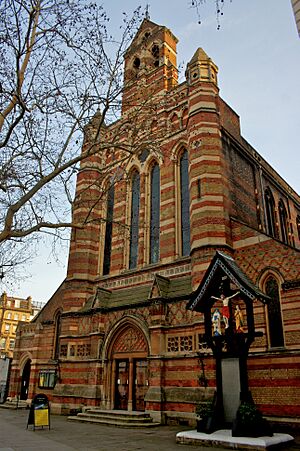St Augustine's, Queen's Gate facts for kids
Quick facts for kids St Augustine's Church |
|
|---|---|
 |
|
| 51°29′36″N 0°10′41″W / 51.4933°N 0.1780°W | |
| Location | Queen's Gate, Brompton, London |
| Country | United Kingdom |
| Denomination | Church of England |
| Churchmanship | Anglo-Catholic |
| History | |
| Dedicated | 1876 |
| Architecture | |
| Architect(s) | William Butterfield |
| Years built | 1865 |
| Administration | |
| Parish | Holy Trinity w St Paul, Onslow Sq and St Augustine, Sth Kensington |
| Deanery | Chelsea Deanary |
| Archdeaconry | Archdeaconry of Middlesex |
| Episcopal area | Kensington Episcopal Area |
| Diocese | Diocese of London |
St Augustine's, Queen's Gate is a beautiful Anglican church located in Queen's Gate, Brompton, London, England. It is a very important old building, officially known as a Grade II* listed site. The church was built in 1865, and its designer was a famous architect named William Butterfield.
Contents
The Story of St Augustine's Church
Starting with a Temporary Church
In 1865, a church leader named Reverend R. R. Chope worked at Holy Trinity, Brompton. He set up a temporary church made of iron in his garden near Gloucester Road. Here, he held church services that were quite different from what people usually expected in an Anglican church at the time.
Building a New Church
The temporary iron church was not big enough. So, a group of important people from Reverend Chope's church decided to ask for a new church to be built. They wanted it to be in South Kensington and called St Augustine's. They even offered to give £100 each year to help pay for it. They also said that Reverend Chope should be the first leader of this new church.
The Bishop of London, A. C. Tait, thought there were already enough churches nearby. He did not agree with the idea at first. But after he became the Archbishop of Canterbury in 1868, things changed. A piece of land was bought, and the new church area was officially created.
Challenges in Building
The land chosen for the church was a bit tricky. At that time, Queen's Gate road did not go all the way to Old Brompton Road. The only way to get to the building site was through what is now Reece Mews. Because of this, the church had to be built at a strange angle compared to Queen's Gate road today.
William Butterfield was chosen as the architect. His plan for the church was estimated to cost £18,000. This was a lot of money, and there wasn't enough to build it all at once. So, they decided to build the church in two parts.
The main part of the church, called the nave, and the side areas, called aisles, were finished in 1871. Services could then begin there. The front part of the church, including the chancel and sanctuary, was completed in 1876. Once finished, the church could seat 853 people. A talented musician named Gerald Hocken Knight was the organist at St Augustine's from 1931 to 1937.
St Augustine's Today
In 2010, St Augustine's Church joined with a nearby church called Holy Trinity Brompton (HTB). By March 2011, St Augustine's became a full part of HTB's parish. The parish was then renamed "Holy Trinity w St Paul, Onslow Sq and St Augustine, Sth Kensington."
Even though HTB is known for its lively and modern style of worship, St Augustine's has kept its traditional services. This includes its Sung Eucharist (a special church service), special clothes for the clergy (vestments), and the use of incense. It continues to follow the Modern Catholic traditions within the Church of England.
Reverend Paul Cowley, who was a curate at HTB, became the 'pastor' at St Augustine's. He had not worked with traditional Anglican services before. He learned the High Mass, which was the main service at St Augustine's. He also made some changes, like replacing some pews (long wooden benches) with chairs. However, original pews are still displayed in other parts of the building, as agreed with English Heritage.
Today, clergy from HTB wear special robes and colored stoles for the weekly 11 am Sung Eucharist service. There is also a Holy Communion service at 9 am. An informal evening service was also started, but it now takes place at St Paul's, Onslow Square. In November 2018, Reverend Tom Jackson took over from Reverend Paul Cowley. Under both these leaders, the church community has grown. St Augustine's is a great example of how different church traditions can work together happily and respectfully.

